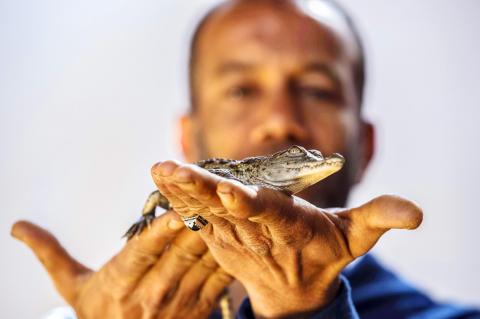Deep in the Nubia, a region along the Nile in southern Egypt, a baby crocodile sat on Mamdouh Hassan’s shoulder to wow tourists.
The reptiles are a source of income for Egypt’s Nubian minority, with visitors paying to marvel at the tamed creatures.
However, beyond bringing in tourist dollars, crocodiles play an important role in the culture of the ethnic group with a history dating to Pharaonic times and its own language.

Photo: AFP
The Nubians traditionally lived along the banks of the Nile in southern Egypt with roots extending into northern Sudan.
In Gharb Soheil, a Nubian village near Aswan, mummified crocodile heads still adorn the doors of the traditional blue-and-white domed homes.
Crocodiles represent an important physical totem of blessings in Nubian belief. In Gharb Soheil, a stuffed crocodile on the door showed that the homeowner kept the large reptiles as pets.
Outside his humble home in the village, Hassan gently rubbed the back of Francesca — a 1.5m-long, 15-year-old crocodile.
“I have raised her since she was born,” the 45-year-old said lovingly of his pride and joy. “She lives on fish, meat and chicken.”
During the reign of former Egyptian president Gamal Abdel Nasser, the construction of the Aswan High Dam created a reservoir over traditional Nubian lands.
When Lake Nasser began filling in 1964, 44 Nubian villages were flooded. While the Nile’s crocodiles benefited from the new habitat, Nasser never fulfilled his promise to adequately compensate Nubians with new land.
Instead, about 50,000 Nubians were displaced to villages north of the dam, on the west bank of the Nile near Kom Ombo and Aswan — a narrow strip of land with limited space for agriculture.
Ever since, Nubians have demanded the return of their lands and have maintained their culture by modernizing their traditions.
Keeping crocodiles became a way to supplement incomes and promote their heritage.
Hassan learned to domesticate crocodiles from his father.
“My father was one of the first people in the Nubian village who really pioneered the idea of bringing in crocodiles as pets to lure tourists,” he told reporters.
In the 20 years since, he has developed a keen sense for where and when wild crocodile eggs will hatch.
Female crocodiles lay their eggs along the banks of Lake Nasser, where Hassan watches for the baby reptiles to emerge before carrying them home.
“The crocodile’s aggressive nature is tempered by growing up in the home with us and being cared for,” he said.
Francesca is the star of the show in the village, Hassan said.
She was named by Italian tourists who enjoyed her sunny personality, so Hassan kept the name.
Visitors snapped selfies with the lounging beasts, while the villagers regaled the tourists with Nubian folk tales about the crocodiles.
Hany, a tourist from Cairo, was delighted with the spectacle of Hassan opening the crocodiles’ mouths wide with his bare hands.
“I came here with my family to spend school holidays, for the kids to enjoy seeing the crocs,” the 35-year-old said.
For ancient Pharaohs, the crocodile-headed god Sobek embodied the fluid nature of the Nile and was prayed to for protection from the annual floods.
A temple is dedicated to Sobek in Kom Ombo, engraved with pictograms and hieroglyphics detailing the embalming of crocodiles.
To this day, Nubians maintain a tradition of crocodile taxidermy, one that remains true to a centuries-old technique.
“Although we know very well the value of crocodile leather, we do not sell it... we cherish it,” Hassan said.
A dead crocodile is skinned from its gut and filled with straw or sawdust.
Large crocodiles take about a month to mummify, while a smaller one dries in a few days, Hassan said.
“This is Franco, who died last month,” he said of the large mummified head of one of his former pets.

To many, Tatu City on the outskirts of Nairobi looks like a success. The first city entirely built by a private company to be operational in east Africa, with about 25,000 people living and working there, it accounts for about two-thirds of all foreign investment in Kenya. Its low-tax status has attracted more than 100 businesses including Heineken, coffee brand Dormans, and the biggest call-center and cold-chain transport firms in the region. However, to some local politicians, Tatu City has looked more like a target for extortion. A parade of governors have demanded land worth millions of dollars in exchange

An Indonesian animated movie is smashing regional box office records and could be set for wider success as it prepares to open beyond the Southeast Asian archipelago’s silver screens. Jumbo — a film based on the adventures of main character, Don, a large orphaned Indonesian boy facing bullying at school — last month became the highest-grossing Southeast Asian animated film, raking in more than US$8 million. Released at the end of March to coincide with the Eid holidays after the Islamic fasting month of Ramadan, the movie has hit 8 million ticket sales, the third-highest in Indonesian cinema history, Film

Taiwan Semiconductor Manufacturing Co’s (TSMC, 台積電) revenue jumped 48 percent last month, underscoring how electronics firms scrambled to acquire essential components before global tariffs took effect. The main chipmaker for Apple Inc and Nvidia Corp reported monthly sales of NT$349.6 billion (US$11.6 billion). That compares with the average analysts’ estimate for a 38 percent rise in second-quarter revenue. US President Donald Trump’s trade war is prompting economists to retool GDP forecasts worldwide, casting doubt over the outlook for everything from iPhone demand to computing and datacenter construction. However, TSMC — a barometer for global tech spending given its central role in the

Alchip Technologies Ltd (世芯), an application-specific integrated circuit (ASIC) designer specializing in server chips, expects revenue to decline this year due to sagging demand for 5-nanometer artificial intelligence (AI) chips from a North America-based major customer, a company executive said yesterday. That would be the first contraction in revenue for Alchip as it has been enjoying strong revenue growth over the past few years, benefiting from cloud-service providers’ moves to reduce dependence on Nvidia Corp’s expensive AI chips by building their own AI accelerator by outsourcing chip design. The 5-nanometer chip was supposed to be a new growth engine as the lifecycle